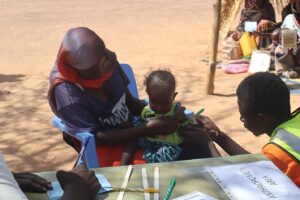By William Madouk
At the heart of Wadwiel Refugee Settlement, Northern Bahr el Ghazal State, the cries of babies resonate through the air as their mothers patiently await their turn in line, to receive much-needed nutritional supplements.
The surge in malnutrition cases has prompted urgent action, with the UN World Food Programme (WFP) and Welt Hungerhilfe (WHH) joining forces to combat this growing crisis.
However, limited funding poses a significant challenge, making their efforts seem like a mere drop in the ocean.
Despite the challenges faced, there is a glow of hope. The collaborative efforts of the WFP and WHH have made a difference in the lives of many mothers and their children.
During an interaction with No. 1 Citizen Daily Newspaper, 20-year-old Mrs. Baitha Ali, a mother of a 7-month-old baby girl who spent two months in a refugee camp, explained the reason for her visit to the nutrition centre and the services they received.
“When I arrived here, my baby’s health wasn’t okay due to malnutrition, and now I brought her here to get some supplements and biscuits,” said Baitha.
“The cause of my baby’s malnutrition is the lack of food, and the living conditions are worse in the camp,” she added.
Another mother, Hawa Khalil, said, “I am here to get biscuits for my daughter, who is 11 months old.”
She described the living conditions in the camp as unbearable due to lack of money and insufficient food.
“You cannot get a balanced diet for your baby; for instance, no potatoes—nothing at all. The food is this biscuit, and posho gives her stomachache, and since I brought her to nutrition, diarrhoea has been there,” Mrs. Hawa lamented.
According to Mrs. Hawa, there is an improvement in her daughter’s overall health, but she waved a red flag over her non-stop running stomach.
She added that they are also sensitized on how to take care of their children’s health through good hygiene.
“I sometimes make porridge for them to survive on even without sugar; I can just use salt and oil or posho with the lentil; this is how we are surviving,” Hawa explained.
Hawa revealed that her husband had been hunting for a job but could not materialize; he has now opted to cut wood for the charcoal business to make ends meet.

Mrs. Ehsan Ali is one of the mothers who came to the centre foe supplemtary food. She said, “The sharp rise in malnutrition was due to rubbish, flies, and dirty latrines, which cause diarrhoea and vomiting among minors and result in undernourishment.”
According to Ehsan, the refugee settlement is not environmentally friendly to the children because of the lack of nutritious food.
Another mother, who identified herself as Amal Adam, narrated what led to her child’s malnourishment.
“My daughter is ill, and she was seriously having diarrhoea and vomiting, so I brought her to the nutrition centre,” said Amal.
Amal, in tears, described the last moment of how one of her children went missing due to a weak fence at the refugee settlement centre.
To her, they would sell out some of the sorghum they received to ensure that they buy other necessities.
Explaining how the nutrition centre works, Mr. Paul Aleu, a nutrition officer with Alight Organization, said that they provide health and nutrition education to mothers at nutrition centers.
Mr. Aleu added that the site received cases of severe and moderate malnutrition and provided them with blanket supplements, including pregnant women and girls in the refugee camp.
“We have a lot of new arrivals who usually come on a daily basis, and we are getting quite a number of children and mothers who are malnourished,” Aleu said.
“At first, in the caseload for severe acute malnutrition, you could see like 12 to 15 children in the program. But as we speak, it increases day by day, and now we are talking of 20 to 25 children in the OPD programme,” he added.
He noted that, per day, they would admit one to two malnourished children on a daily basis.
“As we speak, we have 1,630 beneficiaries in the programme, and with this number, we discharge and also admit,” he noted.
“Actually, we are even worried in the coming period because… not only those children are coming, but we see the malnutrition rate to be high,” he lamented.
According to Aleu, the underfeeding cases were due to the cut in food distribution from 70 to 50 per cent, which severely affected most households, coupled with poor hygiene, leading to diarrhea.




